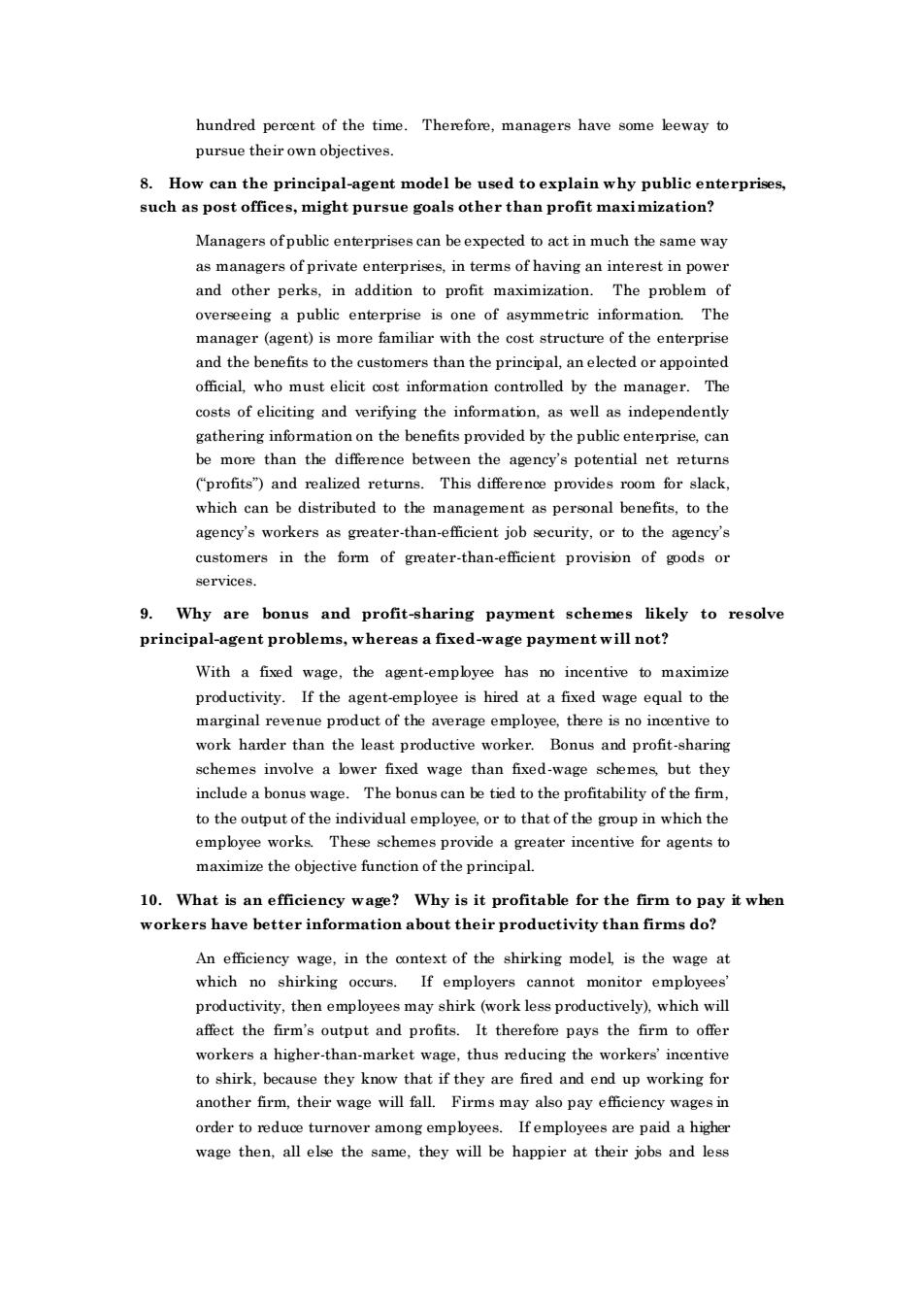正在加载图片...

hundred percent of the time.Therefore,managers have some leeway to pursue their own objectives. 8.How can the principal-agent model be used why publice such as post offic es,might pursue goals other than profit maximization? Managers ofpublic enterprises can be expected to act in much the same way as managers of private enterprises,in terms of having an interest in power and other perks,in addition to profit maximization.The problem of overseeing a public enterprise is one of asvmmetric information.The manager (agent)is more familiar with the cosstructure of the enterprise nd the benefits e customers than the principa orappointe official,who must elicit cost information controlled by the manager. The costs of eliciting and verifving the information.as well as independently gathering information on the benefits provided by the public enterprise.can be more than the difference between the agency's potential net returns Cpois))andealedotms.Thisdio room for slack. which can be distributed to the management as personal be fits,to the agency's workers as greater-than-efficient job security.or to the agency's customers in the form of greater-than-efficient provision of goods or services. 9.Why are bonus and profit-sharing pavment schemes likely to resolve principal-agent problems,whereas a fixed-wage payment will not? With a fixed wage.the agent-emplyee has no incentive to maximize productivity.If the agentemployee is hired at a fixed wage equal to the marginal revenue product of the average employee.there is no incentive to work harder than the least productive worker.Bonus and profit-sharing schemes involve a lower fixed wage than fixed-wage schemes.but thev include a bonus wage.The bonus can be tied to the profitability of the firm to the output of the individual employee,or to that of the group in which the employee works. These schemes provide a greater incentive for agents to maximize the objective function of the principal. 10.What is an efficiency wage?Why is it profitable for the firm to pay it when workers have better information about their productivity than firms do? An efficiency wage.in the context of the shirking model is the wage at which no shirking。 urs. cannot vity,then employees may shirk (work less productiv ely).which wil affect the firm's output and profits.It therefore pays the firm to offer workers a higher-than-market wage.thus reducing the workers'incentive to shirk,because they know that if they are fired and end up working for another firm.their wage will fall.Firms may also pay efficiency wages in er among e are paid wage then.all e the same.they will be happier at their jobs and les hundred percent of the time. Therefore, managers have some leeway to pursue their own objectives. 8. How can the principal-agent model be used to explain why public enterprises, such as post offices, might pursue goals other than profit maximization? Managers of public enterprises can be expected to act in much the same way as managers of private enterprises, in terms of having an interest in power and other perks, in addition to profit maximization. The problem of overseeing a public enterprise is one of asymmetric information. The manager (agent) is more familiar with the cost structure of the enterprise and the benefits to the customers than the principal, an elected or appointed official, who must elicit cost information controlled by the manager. The costs of eliciting and verifying the information, as well as independently gathering information on the benefits provided by the public enterprise, can be more than the difference between the agency’s potential net returns (“profits”) and realized returns. This difference provides room for slack, which can be distributed to the management as personal benefits, to the agency’s workers as greater-than-efficient job security, or to the agency’s customers in the form of greater-than-efficient provision of goods or services. 9. Why are bonus and profit-sharing payment schemes likely to resolve principal-agent problems, whereas a fixed-wage payment will not? With a fixed wage, the agent-employee has no incentive to maximize productivity. If the agent-employee is hired at a fixed wage equal to the marginal revenue product of the average employee, there is no incentive to work harder than the least productive worker. Bonus and profit-sharing schemes involve a lower fixed wage than fixed-wage schemes, but they include a bonus wage. The bonus can be tied to the profitability of the firm, to the output of the individual employee, or to that of the group in which the employee works. These schemes provide a greater incentive for agents to maximize the objective function of the principal. 10. What is an efficiency wage? Why is it profitable for the firm to pay it when workers have better information about their productivity than firms do? An efficiency wage, in the context of the shirking model, is the wage at which no shirking occurs. If employers cannot monitor employees’ productivity, then employees may shirk (work less productively), which will affect the firm’s output and profits. It therefore pays the firm to offer workers a higher-than-market wage, thus reducing the workers’ incentive to shirk, because they know that if they are fired and end up working for another firm, their wage will fall. Firms may also pay efficiency wages in order to reduce turnover among employees. If employees are paid a higher wage then, all else the same, they will be happier at their jobs and less